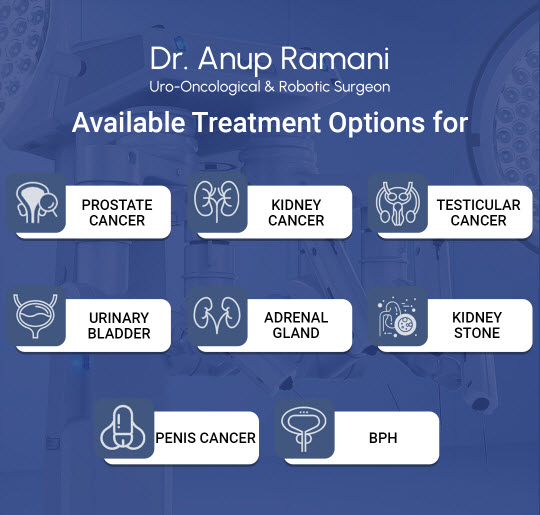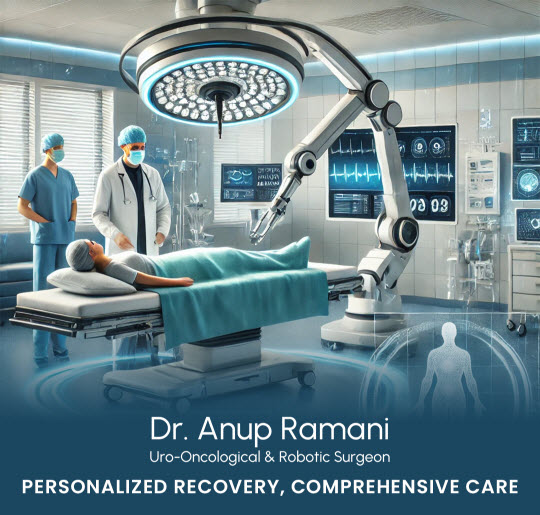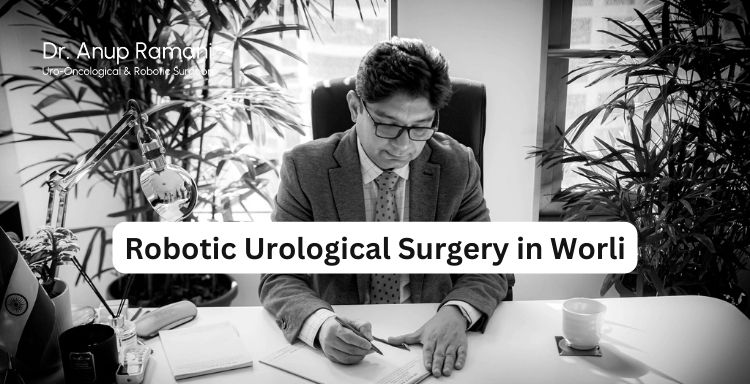Dr Anup Ramani @ Copyright 2024
By Dr. Anup Ramani
When it comes to advanced urological care, the field is constantly evolving with new technologies that make treatments more effective and less invasive. One of the most significant breakthroughs in recent years has been robotic urological surgery, a game-changing option for many patients. At the forefront of this revolution in Mumbai, particularly in the Worli area, Dr. Anup Ramani is a pioneering uro-oncologist with over 20 years of experience. Dr. Ramani is not only a leader in robotic surgery but was also the first to introduce this technology in uro-oncology in India.
Dr. Anup Ramani
Dr. Anup Ramani is recognized as one of the leading uro-oncologists in Mumbai, specializing in robotic surgery for various urological cancers. With a career that spans over two decades, Dr. Ramani has performed more than 2,000 robotic procedures, making him a top expert in his field. His vast experience, coupled with his pioneering spirit, has made him a go-to specialist for patients seeking advanced, minimal invasive treatments for urological conditions.
Dr. Ramani’s expertise includes treating cancers of the prostate, kidneys, adrenal glands, bladder, penis, and testicles. His specialties include complex procedures like robotic radical prostatectomy, robotic radical nephrectomy, and robotic cystectomy, among others. By utilizing cutting-edge robotic systems, he has transformed the surgical landscape in uro-oncology, particularly in areas like Worli, where he offers world-class care to both local and international patients.
Robotic Surgery: The Future of Urological Care
Robotic surgery represents a major advancement in urological treatments. It offers a minimal invasive approach, providing surgeons with enhanced precision, flexibility, and control during operations. The use of robotic systems enables smaller incisions, reduced blood loss, quicker recovery times, and minimal scarring compared to traditional open surgery.
For patients, this means less post-operative pain and a faster return to normal activities. But for the surgeon, robotic surgery offers improved accuracy, especially when dealing with delicate and complex structures in the pelvic region. This is why experts like Dr. Anup Ramani have adopted this technology to handle the intricacies of urological cancer treatments with greater ease and better outcomes.
How Dr. Anup Ramani is Leading the Way in Worli
As a resident of Worli or a patient seeking treatment in this prime area of Mumbai, you have access to one of India’s top uro-oncologists. Dr. Anup Ramani has not only been a key figure in introducing robotic surgery to India but has also helped elevate the standard of care available to patients in Worli. His approach integrates state-of-the-art technology with patient-centered care, ensuring that every individual receives tailored treatment that addresses their unique medical needs.
Here are some of the key robotic urological surgeries that Dr. Ramani specializes in:
1. Robotic Radical Prostatectomy for Prostate Cancer
Prostate cancer is one of the most common cancers among men, but early detection and treatment greatly improve outcomes. Dr. Ramani specializes in robotic radical prostatectomy, a surgery that removes the prostate gland using robotic assistance. The precision offered by robotic systems minimizes damage to surrounding tissues, preserving urinary and sexual function while ensuring effective cancer removal.
2. Robotic Radical Nephrectomy and Nephron-Sparing Surgery for Kidney Cancer
For patients with kidney cancer, Dr. Ramani offers both robotic radical nephrectomy (removal of the kidney) and nephron-sparing surgery (partial removal of the kidney, preserving healthy tissue). These procedures are designed to treat cancer while maintaining as much kidney function as possible. Robotic systems allow Dr. Ramani to perform these surgeries with unmatched precision, reducing the risks associated with traditional surgery.
3. Robotic Radical Cystectomy for Bladder Cancer
Bladder cancer often requires complex surgery, but with robotic radical cystectomy, Dr. Ramani is able to remove the bladder with minimal impact on the patient’s recovery. This technique is especially beneficial in reducing post-operative complications and ensuring a faster return to daily activities.
4. Robotic Adrenalectomy for Adrenal Tumors
For tumors affecting the adrenal glands, robotic adrenalectomy is a minimal invasive option that reduces the risk of complications. Dr. Ramani has extensive experience in this procedure, which allows for the safe removal of adrenal tumors while preserving surrounding structures.

5. Partial Penectomy for Penile Cancer
Penile cancer, though rare, requires specialized care. Dr. Ramani performs partial penectomy, where only part of the penis is removed, using robotic technology to ensure precision and limit the impact on the patient’s quality of life.
6. Robotic Pyeloplasty for Ureteral Obstruction
Robotic pyeloplasty is used to correct blockages in the ureter, which can cause kidney function to decline. By employing robotic technology, Dr. Ramani ensures that this delicate procedure is performed with accuracy, minimizing the risk of future complications and enhancing the patient’s recovery experience.
Benefits of Robotic Urological Surgery
There are numerous benefits to choosing robotic surgery for urological conditions, especially under the expert care of Dr. Anup Ramani:
- Greater Precision: Robotic systems allow for precise movements that aren’t possible with human hands, making it easier to perform complex surgeries.
- Minimized Blood Loss: The smaller incisions and precise control result in less bleeding during surgery.
- Faster Recovery: Patients often experience faster recovery times with robotic surgery, meaning they can get back to their daily routines sooner.
- Less Pain and Scarring: The minimal invasive nature of robotic surgery means smaller scars and less post-surgical pain.
- Better Cancer Control: For cancer surgeries, the precision of robotic systems can lead to more effective removal of cancerous tissues.
Worli: A Hub for Advanced Urological Care
Worli, one of Mumbai’s key neighborhoods, is not only known for its bustling lifestyle but also as a hub for advanced medical care. Dr. Ramani’s presence in Worli means that patients in this area have access to the latest in robotic urological surgery without needing to travel far. His state-of-the-art facilities are designed to provide the best possible care in a comfortable and convenient setting.
Global Reach of Dr. Anup Ramani
While Dr. Ramani is based in Mumbai, his reputation as a leading uro-oncologist has brought patients from around the world to seek his expertise. With his experience in over 2,000 robotic surgeries and numerous successful outcomes, Dr. Ramani offers his services to patients not only from India but also from other countries, making him a sought-after expert in robotic urological surgery.

Conclusion
Robotic surgery has opened up new possibilities in the treatment of urological cancers, providing patients with safer, more effective options. In Worli, Dr. Anup Ramani is at the forefront of this revolution, offering cutting-edge treatments for a wide range of urological conditions. Whether it’s prostate cancer, kidney cancer, or other complex urological conditions, Dr. Ramani’s expertise ensures that patients receive the best care with the least disruption to their lives.
For those seeking advanced urological care in Worli or beyond, Dr. Anup Ramani offers a combination of world-class technology, extensive experience, and a commitment to patient-centered care. His leadership in robotic surgery continues to set new standards in uro-oncology, making him a top choice for anyone facing urological challenges.
Call now to book your appointment with Dr. Anup Ramani for expert uro-oncological treatment in Worli, Mumbai, and worldwide!
About Author

Uro-Oncological & Robotic Surgeon
Dr. Anup Ramani is a robotic uro-oncological surgeon and an internationally recognized expert in robotic surgery for prostate, kidney and urinary bladder cancers. With more than two decades of robotic experience and 2,000+ robotic procedures, he brings unmatched precision and outcomes to complex uro-oncology cases. He is widely published in his field and is known for a personal, transparent approach-often spending over an hour in initial consultations to educate patients on its disease, surgery and recovery. His expertise spans prostate cancer treatment, kidney and bladder cancer surgery, adrenal gland surgery, kidney stone treatment, penile cancer surgery and enlarged prostate management. Dr. Ramani advocates the advantages of robotic surgery-magnified 3D vision, tremor-filtered precision, minimal scarring, lower blood loss and faster recovery-helping patients return to life sooner.
Table of Contents
Recent Blogs
Best Uro-Oncological surgeon
Specialist in India for Robotic Surgery
MCh, DNB, MS, DNB
Dr. Anup Ramani
CONTACT
Uro-Oncologist in India,
Best Robotic Surgeon for Uro Oncology Surgery
1407, One Lodha Place Next to World Towers Senapati Bapat Marg, Worli, Mumbai. 400013.
Dr Anup Ramani @ Copyright 2024 – Website Maintenance, SEO & GEO by Opal Infotech
- Partial penectomy is done in cases where glans and distal penis is involved with carcinoma.
- Partial penectomy is a type of organ-preserving surgery. Preservation of sexual and micturational function depends on the surgical dissection and reconstruction of residual urethra.
- Patients who develop stones in the kidney or ureter, often experience severe pain.
- This condition usually needs a procedure to remove the kidney stones.
- This procedure is called ureteroscopy and is performed very commonly.
- It does not require any cuts and hence it is painless.
- The procedure is performed with an endoscope inserted through the penis under spinal anesthesia.
- The scope is inserted through the penis into the kidney and stones are dissolved with a laser.
- The procedure takes about 40-50 minutes.
- A catheter (urine pipe) is kept after the procedure to drain the bladder. A stent is kept in the kidney at the same time.
- Patient is mobile and walking in the room the same evening.
- Hospital stay is one night and patient is discharged the next day after removal of the catheter.
- Patient has to come back after six weeks to remove the stent in the kidney.
- Patients can resume office a week after surgery and heavy activities like running, weight lifting, a month after the procedure.
- We offer fixed packages for this procedure which can be obtained by calling our helpline +91 9967666060.
- Men with an enlarged prostate, which is a normal ageing changes, often experiencing difficulty passing urine. This condition usually needs a procedure to trim the prostate and relieve the blockage.
- This procedure is called TURP and is performed very commonly.
- It does not require any cuts and hence it is painless.
- The procedure is performed with an endoscope inserted through the penis under spinal anaesthesia.
- The overgrown prostate is dissolved with a laser bloodlessly.
- The procedure takes about 40 minutes.
- A catheter (urine pipe) is kept after the procedure to drain the bladder.
- Patient is mobile and walking in the room the same evening.
- Hospital stay is two nights and patient is discharged with the catheter, which is removed after 4 days.
- Patients can resume office a week after surgery and heavy activities like running, weight lifting, a month after the procedure.
- We offer fixed packages for this procedure which can be obtained by calling our helpline +91 9967666060.
-
Robotic adrenalectomy is a sophisticated, complex surgery and it is very important that an experienced surgeon performs this surgery to avoid major complications.
-
Once the anesthesia is done, and patient positioned, three micro cuts (3mm each) are made in the patient’s abdomen.
-
The arms of the Da Vinci robot are connected to the cuts via ports (tubes).
-
Dr. Ramani then sits in the controlling console to perform the surgery.
-
On an average, a robotic adrenalectomy takes one hour.
-
The surgery is almost completely bloodless and there has never been any need to transfuse blood after surgery.
-
A urine catheter and bag to drain the bladder is inserted during surgery.
-
A tiny drain pipe may be inserted in the surgical side of the abdomen, connected to a bag.
-
Patient is kept nil-by-mouth the day of the surgery, with IV fluids. Sips of water are started the next day and solid food by day three.
-
The drain pipe, if kept, is removed in the room on day 2 after surgery.
-
The catheter is removed on day two after surgery.
-
Total hospital stay for robotic adrenalectomy is 4 nights (including night before surgery).
-
Post discharge, a doctor from the surgical team visits the patient at home/ hotel room once every day.
On the day of discharge, patient is totally self-sufficient. They are able to walk freely without any pain, dress themselves, shower, toilet and they do not need to hire any nurse or help at home. Almost all patients are back to work within 2 weeks of surgery.
Heavy activities like running, weight lifting can be resumed after a month
Follow up after an adrenalectomy is in the form of CT scans, once a year for 5 years.
Local patients usually meet Dr. Ramani after two weeks to discuss report.Outstation patients are counselled on a phone consultation.
- Dr. Ramani is one of the very few surgeons in India who has the expertise to perform a robotic surgery for bladder cancer, which includes removing the urinary bladder and reconstructing a new bladder robotically.
- Robotic radical cystectomy is an extremely sophisticated, complex surgery and it is very important that an experienced surgeon performs this surgery to avoid major complications.
- Once the anaesthesia is done, and patient positioned, six micro cuts (3mm each) are made in the patient’s abdomen.
- The arms of the Da Vinci robot are connected to the cuts via ports (tubes).
- Dr. Ramani then sits in the controlling console to perform the surgery.
- On an average, a robotic radical cystectomy with an ileal conduit takes 3-4 hours.
- The surgery is almost completely bloodless and there has never been any need to transfuse blood after surgery.
- A urine catheter and bag to drain the new bladder is inserted during surgery.
- Two tiny drain pipe in inserted in the surgical side of the abdomen, connected to a bag.
- Patient is kept nil-by-mouth for 4 days after surgery with IV supplementation of patient’s daily requirements of calories, fats, carbohydrates, proteins and electrolytes.
- The drain pipes are removed in the room on day 3-5 after surgery.
- Total hospital stay for radical cystectomy is 8 nights (including night before surgery).
- Post discharge, a doctor from the surgical team visits the patient at home/ hotel room once every day.
- On the day of discharge, patient is totally self-sufficient. They are able to walk freely without any pain, dress themselves, shower, toilet and they do not need to hire any nurse or help at home.
- Almost all patients are back to work within 6 weeks of surgery. Heavy activities like running, weight lifting can be resumed after two months.
Follow up after a radical a cystectomy is in the form of CT scans, once a year for 5 years.
Histopathology report: Local patients usually meet Dr. Ramani after two weeks to discuss report.
Outstation patients are counselled on a phone consult. Depending on the report, patient may or may not need chemotherapy after surgery.
If chemo is needed, patients may choose to get it done with a medical oncologist of their choice or avail the services of one of the four medical oncologists on our team.
- Robotic partial nephrectomy is a sophisticated, complex surgery and it is very important that an experienced surgeon performs this surgery to avoid major complications. Robotic radical (total) nephrectomy is
- relatively easier but still requires significant experience to consistently deliver results.
- Once the anaesthesia is done, and patient positioned, five micro cuts (3mm each) are made in the patient’s abdomen.
- The arms of the Da Vinci robot are connected to the cuts via ports (tubes).
- Dr. Ramani then sits in the controlling console to perform the surgery.
- On an average, a robotic radical nephrectomy takes one hour and a robotic partial nephrectomy takes about an hour and half.
- The surgery is almost completely bloodless and there has never been any need to transfuse blood after surgery.
- A urine catheter and bag to drain the bladder is inserted during surgery.
- A tiny drain pipe in inserted in the surgical side of the abdomen, connected to a bag.
- Patient is kept nil-by-mouth the day of the surgery, with IV fluids. Sips of water are started the next day and solid food by day three.
- The drain pipe is removed in the room on day 3 after surgery. The catheter is removed on day two after surgery.
- Total hospital stay for radical/partial nephrectomy is 4 nights (including night before surgery).
- Post discharge, a doctor from the surgical team visits the patient at home/ hotel room once every day.
- On the day of discharge, patient is totally self- sufficient.
- They are able to walk freely without any pain, dress themselves, shower, toilet and they do not need to hire any nurse or help at home.
- Almost all patients are back to work within 2-3 weeks of surgery.
- Heavy activities like running, weight lifting can be resumed after a month.
- Follow up after a radical/partial Nephrectomy is in the form of CT scans, once a year for 5 years.
- Local patients usually meet Dr. Ramani after two weeks to discuss report.
- Outstation patients are counselled on a phone consultation.






